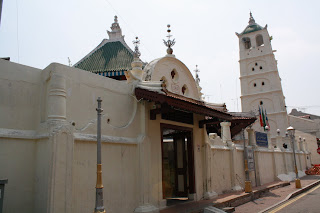My apologies for the delay in posting. Myanmar blocked all things affiliated with Google (Blogger being one of them) therefore, I could not post.
 I posed a question in my last posting, asking if whether or not different religious groups could live peacefully next to each other. In contrast to the religious fighting, rioting and upheaval between Buddhist and Muslims in Southern Thailland that I experienced, roughly 50 miles across the border in Malaysia, Hindus, Muslims, Christians and Buddhist all live peacefully next to each other. It is a truly amazing sight to witness girls in head coverings walking out of school with their friends in plain western style clothes, chattering and giggling away at what I am assuming to be the lastest gossip or love interest ; or prehaps more striking is the image of Buddhist monks leaving their monestaries and walking pass a Muslim mosque. I think that it is the historical significance and geographical position of Malaysia that makes it quite unique in acceptance of differences. Being at the cross roads of sea routes , the gate way for ships from China to go to Europe and/or the Middle East, and vice-versa, I would conjure that the peoples of Malaysia are accustomed to welcoming in « strangers » and making them into « friends. » In my short time in Malaysia, I have noticed that differences seem to be the norm rather than the exception.
I posed a question in my last posting, asking if whether or not different religious groups could live peacefully next to each other. In contrast to the religious fighting, rioting and upheaval between Buddhist and Muslims in Southern Thailland that I experienced, roughly 50 miles across the border in Malaysia, Hindus, Muslims, Christians and Buddhist all live peacefully next to each other. It is a truly amazing sight to witness girls in head coverings walking out of school with their friends in plain western style clothes, chattering and giggling away at what I am assuming to be the lastest gossip or love interest ; or prehaps more striking is the image of Buddhist monks leaving their monestaries and walking pass a Muslim mosque. I think that it is the historical significance and geographical position of Malaysia that makes it quite unique in acceptance of differences. Being at the cross roads of sea routes , the gate way for ships from China to go to Europe and/or the Middle East, and vice-versa, I would conjure that the peoples of Malaysia are accustomed to welcoming in « strangers » and making them into « friends. » In my short time in Malaysia, I have noticed that differences seem to be the norm rather than the exception. The day before I left Melala, I had the opprotunity to sit down for a Chinese Tea ceremony with one of the daughters of the Chen family—one of the first Chinese families which came to Melaka during the Ming dynasty. Over tea, I expressed to her my facination with Melaka, Malaysia and the culture of openness and acceptance. She smiled at me and responded simply, « when you grow up in a diverse environment as this, you learn that to live happily, respect for one another is the key. »
The day before I left Melala, I had the opprotunity to sit down for a Chinese Tea ceremony with one of the daughters of the Chen family—one of the first Chinese families which came to Melaka during the Ming dynasty. Over tea, I expressed to her my facination with Melaka, Malaysia and the culture of openness and acceptance. She smiled at me and responded simply, « when you grow up in a diverse environment as this, you learn that to live happily, respect for one another is the key. »




1 comment:
I especially love the description of the prayer calls/chanting in the morning. How beautiful!
Post a Comment